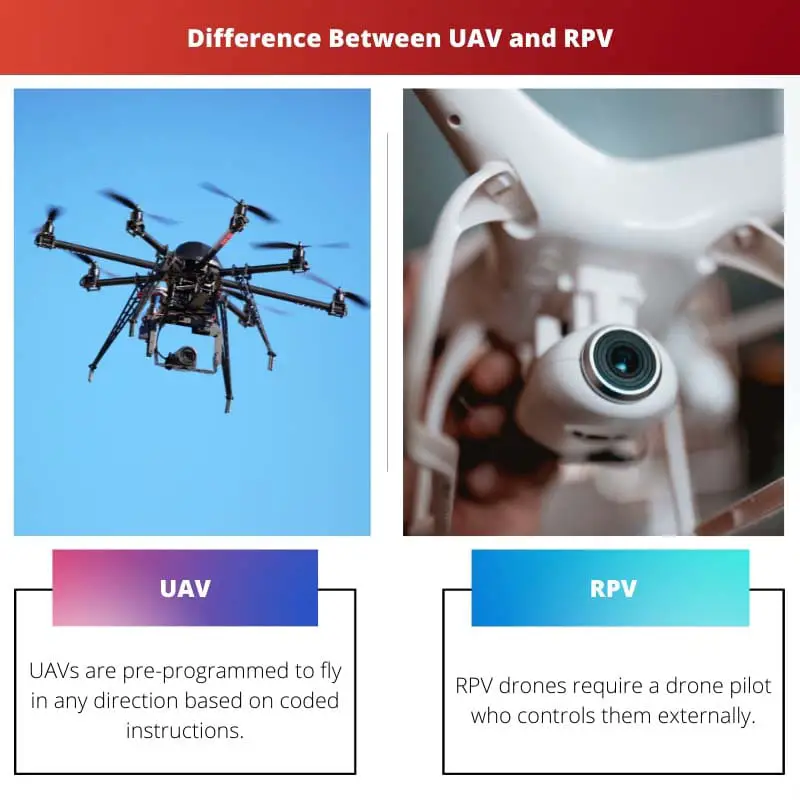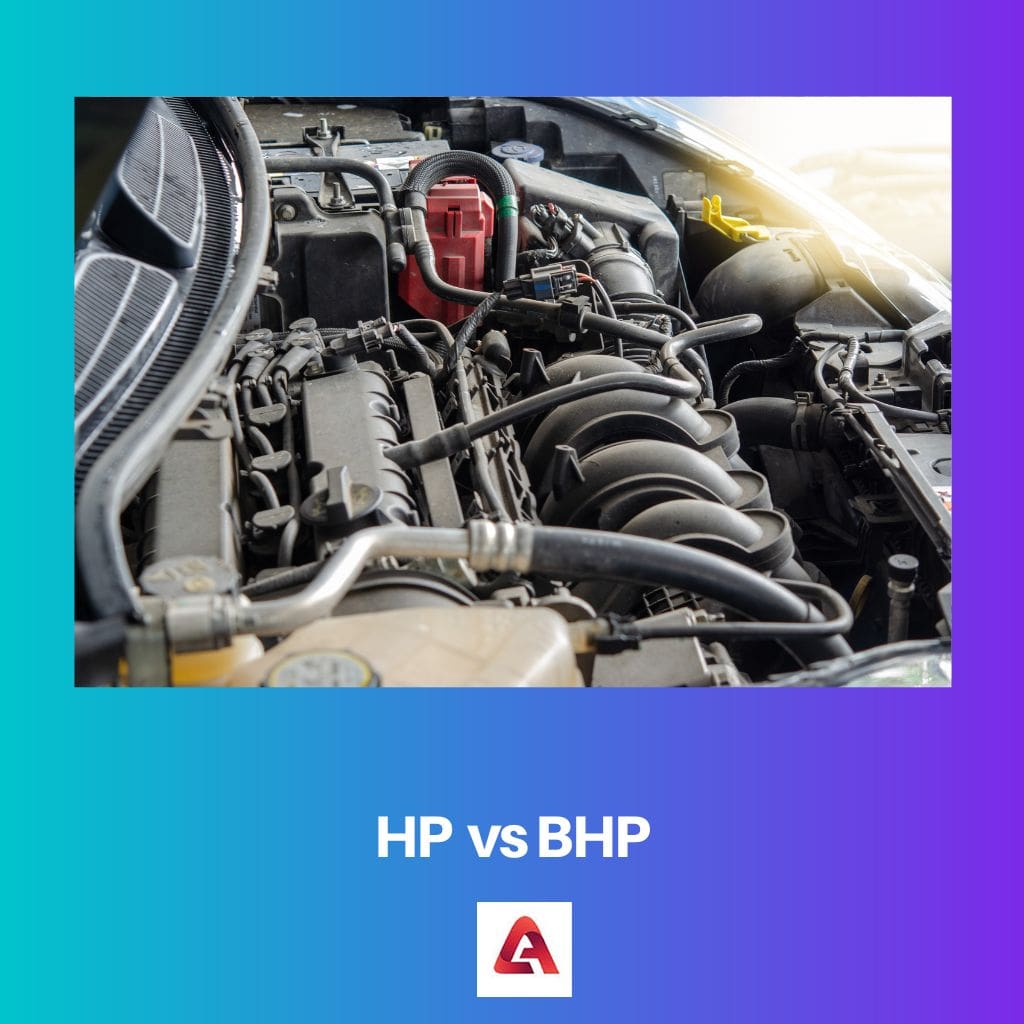Drones are robotic and pilotless aircraft, similar to modern unarmed aircraft vehicles of the aviation business.
It is possible to fly a drone with remote controls operated by experts, or they can be set to autopilot mode, requiring no internal or external assistance.
Depending on their installed features, drones are categorized as single-motor, multi-motor, or fixed-wing drones.
UAVs and RPVs are both high-level flying robots (drones). A UAV is a drone that does not require external or internal pilots and operates using auto-pilot mode technology, whereas RPV is a drone that does not have a pilot but is controlled and operated by humans from the outside. Let’s understand in detail.
Key Takeaways
- UAVs (Unmanned Aerial Vehicles) can operate autonomously or remotely, while RPVs (Remotely Piloted Vehicles) require human control.
- UAVs cover a broader category of aircraft, while RPVs are a specific subset of UAVs.
- UAVs have diverse applications, including military, research, and commercial uses, while RPVs are predominantly used for military purposes.
UAV vs RPV
UAVs are autonomous aircraft that are programmed to fly and operate without human intervention. They are used for surveillance, reconnaissance, and data collection purposes. RPVs are unmanned aircraft that human operators control from the ground. They are used for military purposes.

UAV is an abbreviation used for unmanned aerial vehicles, or in naïve terms, and it is called an unarmed flying robot. Nikola Tesla also mentions this invention in the year 1915.
Before the first world war, A.M. Low first designed such drones in the early twentieth century. Following WWI, this technology reached new heights in terms of advancement.
The abbreviation RPV stands for remotely piloted vehicles, which are similar in structure to unmanned aerial vehicles (UAVs) but require external help to fly.
These first appeared in the US Army forces in early 2000. Drone pilots receive at least six months of special training to control these drones.
Comparison Table
| Parameters of Comparison | UAV | RPV |
|---|---|---|
| Technology | UAVs are pre-programmed to fly in any direction based on coded instructions. | RPV drones require a drone pilot who controls them externally. |
| Full Name | The full name of the UAV drone is an unmanned aerial vehicle. | The remotely piloted vehicle is the full name for RPV drones |
| Motor used | A brushless motor has been installed to carry extra weight on the UAV. | Both brushless motors and electric motors are installed in RPV. |
| Applications | An unmanned aerial vehicle is for surveillance, mapping, and temperature mapping. | Remotely piloted vehicles could be used for lethal targets and surgical strikes like a pilot plane. |
| Problems Involved | Since UAV drones have low levels of security, they can be easily hacked. | Drones may be unable to fly due to remote technology failure. |
What is UAV?
An unmanned aerial vehicle is the full name of this type of aircraft. An unarmed aerial vehicle is any drone that is not armed (such as a drone without a pilot, crew, or passenger).
Flying instructions have already been programmed into the software, and it flies following them.
UAVs are used extensively in a variety of industries, including military, agricultural, and transportation.
Drones are used in the military to spy on enemies and to communicate, such as passing sensitive information via artificial intelligence.
Water-resistant UAVs help farmers water their crops using drip irrigation in the agriculture industry and determine the height of the plants.
These drones are utilized for thermal mapping, which detects and adjusts the temperature according to crop needs.
Unarmed aerial vehicles are employed in the transportation sector to convey parcels, vital medicines, and food. Aside from that, they can be used to keep an eye on VIP vehicles for security and transparency reasons.
The unmanned aerial vehicle comes equipped with many technological devices, such as advanced GPS, high-definition cameras, and lasers.
The motor system installed in these drones is a brushless motor (based on direct current, does not require mechanical brushes, and has a power-saving mode).
What is RPV?
RPV stands for a remotely piloted vehicle that has been classified as a drone. As the name implies, these flying robots(drones) need the external aid of trained aircraft pilot to fly and does not consist of any man inside the drone.
Instead of being controlled by programming, these drones are piloted by real-time trained pilots using wireless remote controls. The pilot must have 800 hours of training, certification, and a permit to fly a remotely piloted vehicle.
RPVs are essential for agriculture activities, especially, in hilly terrain, for monitoring crops and spotting any problems. Apart from that, they are used in civil
and military applications for transporting essential products and spying on adversaries, just as UAVs.
Small RPVs include a single electric motor. They can fly to the height of 100 feet.
However, full-fledged drones can cover a vertical distance of up to 400 feet with above ground level (AGL) permit assigned by higher authorities of the area where a drone has to fly.
RPVs can be used in lethal situations with an enemy, such as surgical strikes, since their functions are comparable to those of ordinary pilot aircraft.
These are also classified as fixed-wing drones (drones whose wings do not move while taking off).
Main Differences Between UAV and RPV
- The full form of UAV is an unmanned aerial vehicle. On the other hand, the full form of RPV is a remotely piloted vehicle.
- The programmers who code such drones based on artificial intelligence control the UAVs’ flight. In the case of RAV, skilled pilots use remote controls to control the flight.
- Unmanned aerial vehicles (UAVs) cannot be operated in battles or dangerous situations. On the other side, a remotely piloted vehicle can be used in combat situations.
- The UAVs’ motors are based on direct current and do not have mechanical brushes. The installed motor in RVP might be brushless or electric.
- The unmanned aerial vehicle’s maximum weight is 150 kg. On the other hand, RPVs have a maximum weight of 100 kg.





